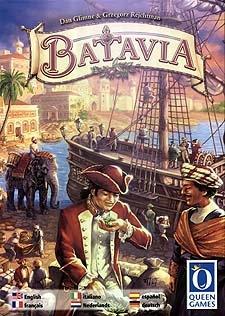28th November 2012Arrived to find the usual suspects already engaged in gaming and a group at the back table about to start a game of
Coup
Which in the end, I believe, ended being several games but as it is a quick game that is not surprising. I did get invited to play but another two late arrivals meant I deferred my place to them and began setting up for a game of
Batavia
This being a Queen game the components are top notch with wooden pieces, great artwork and really well designed board.
Each player is a merchant trying to visit different trading posts to collect commodities a gain gold (victory points) with the richest merchant at the end of the game is the winner.
All players start with 15 promissory notes, a hand of 10 cards depicting one of the five East India companies and a number of crates, at the start of the round the first player rolls a dice and this is the number of cards dealt from the draw pile to be put up for auction along with first player. The person to the left of the start player bids for the cards and then everyone else ups the bis or passes. The winner of the bod gets the cards and first player then pays his bid as evenly as possible to all the other players.
On your turn you either draw 2 cards or you can play cards, in order to play cards you need to be able to lay enough cards to create a majority in one of the 5 East India companies, if you already have a majority then you can just play any card. When you have played as many cards as you want you then choose one of majorities you have and move your merchant to the nearest Trading post of that company on the track. You collect the trading post and put one of your crates on the match commodity space. If this trading post is from an East India company you have not previously collected from then you can opt to cash in a set of different trading posts for Gold. Each of the commodities has a slot for each of the 5 east India companies and vary in value, at the end of the game the person with the most crates for that commodity scores a number of gold (10-16 depending on which one) if two people tie then they both get a much smaller amount of gold each.
As more cards get laid out a Cannon is moved along a track to keep a count of the total, plus markers for each East India company keep track of how many cards of each company are out. When the Cannon reaches 21+ or 25+, depending on the number of players, the Pirates attack at the end of that players turn. When they attack the cards belonging to the East India Company with the most cards out are sunk and put in a discard pile, if one or more Companies tie for the most then all the cards for tied companies are removed. The markers are returned to zero and the Cannon moved back to reflect the current number of cards.
The end game is triggered when someone takes the Target Trading Post from the board, which scores the owner 4 Gold, this is taken when a trading post of the East India company the active player wants to move to is not available. That round is completed, players who find they are unable to move to a trading post have to take cards. The game is then scored, each player lays out all of their cards that remain in their hands and the majorities are then reassessed for each majority a player has they score 2 gold. The commodities are scored and finally the player with the most promissory noted gets 5 gold.
This game is quick to play, easy to teach but has plenty of strategy and depth. I find this a really fun game to play and will always be willing to get this to the table, there is certainly a amount of luck to this game but it does not detract from the enjoyment.

After this we went on to play
Through the Desert which is a classic German game but still a lot of fun. Each player has the same set of coloured camels and the board is laid out with Oasis and scoring tiles. In turn players lay out their starting camels (which have a rider on of their player colour) one at a time, once they are all out play commences. Each turn players add 2 camels to one of their camel trains, if they land on a scoring marker they take that, if they move next to an oasis they score 5pts and take a marker of that value from the pool, if they manage to surround an area with their camel train they can take the counters within and will score the spaces at the end. There are points for the largest Camel train in each of the colours and the end game is triggered when all of the camels of one colour have been used.
This game is quite fun but the pastel colours of the camels plus the fact there will be several players trains of the same colour means sometimes the board looks very busy and it is easy to get confused.
Nonetheless it is an enjoyable game.


